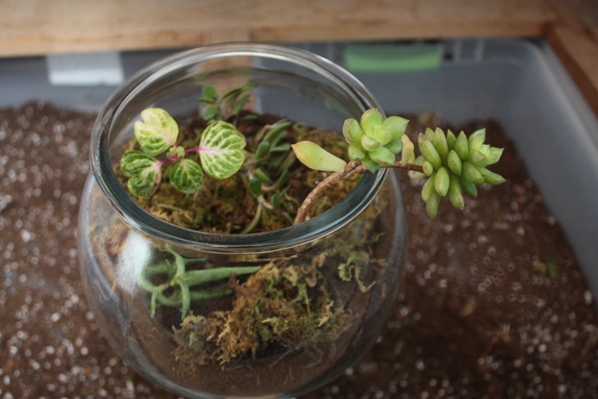
A terrarium is basically a miniature greenhouse. It is essentially a glass container with plants growing in the interior. One of the beautiful parts of the terrarium is the glass container. Almost any glass container will work from a flower vase to gold fish bowl. Originally the terrarium was called a Wardian case. This was a piece that is still in production today and consists of the glass terrarium on legs. Wardian cases were very ornate and reminiscent of the Victorian era. Today we simply use the glass terrarium and tend to forgo the legs.
I have found all of my glass containers for under $1.00. I had a friend with an old fish bowl and I instantly saw its potential as a terrarium. Another piece came from a local thrift shop and the last two were discovered at a yard sale. You can use an old pickle jar, wine glass or full scale aquarium. Any glass container with an opening at top will suffice. To add more interest to your terrarium keep an eye out for different shapes. A container with a curved lip or narrow base will add visual interest and look more significant than a plain piece.
The glass container will not have drainage so you need to create space for the water. If too much water accumulates mold will develop and your plants can eventually die. To prevent this all you need is gravel or smooth stone. Approximately two to three inches of gravel will suffice then add a thin layer of charcoal which keeps your potting soil sweet. The charcoal adds nourishment to the plants, especially if you use any orchids.

The next layer should be the potting mix. I have used both potting mix and potting soil. Potting soil is what you find at most gardening stores. It is soft and light weight when dry, but when wet, it becomes thick and very dense which prevents proper drainage. Potting mix on the other hand contains more organic materials. This can have sphagnum moss and bark chips. The mixture has more space for drainage and air flow which is paramount in a closed container like a terrarium. One of the first terrariums I made used potting soil and within a few weeks the soil had turned green because of the built-up moisture.
Next I start to add the plants. Many sources say you should only use true miniature plants. While a true miniature makes maintenance easy, it is not necessary. I tend to propagate existing plants for the terrariums. The plants will have to be consistently pruned to a manageable size but this way I do not have to spend any money for new plants. Almost any plant will work. Common plants include ferns, mosses, begonias and carnivorous plants.
Serious terrarium growers create full landscapes in their terrariums including rocks, rivers, and miniature mountains. For those of us who are not quite as advanced, there are a few basic tricks to creating some pizzazz in the terrarium. To create a sloped appearance insert a handful of Styrofoam packing peanuts and then cover the pieces with the potting mix. The terrarium can easily become a lot of brown and greens which can get boring. To add a bit of contrast I place cream colored gravel in the bowl. I have also placed reindeer moss and sphagnum moss between the plants for a bit of added texture.
As a rule of thumb, three plants look better than two plants because odd numbers are more pleasing to the eye. A tall plant, a vining plant, and a medium sized plant work well together. The tall plant tends to go in the center with the vining plant closest to the glass and the mid-sized plant spaced in-between. As another general guideline plants of similar colors go well together. Plants with green foliage should be grouped together and plants with blue hues should stay in a separate assembly. You can also try to coordinate bloom colors if your terrarium has any flowers. Play with different set-up’s and see what you like the most. I usually re-arrange my plants several times until I am satisfied. After finalizing the layout simply place more mix around the plants and your terrarium is almost ready.
After you have finished the final touches you can add a glass topper. The glass piece will create humidity in the terrarium, but too much and your bowl will develop condensation. It is important to keep an eye on the terrarium and remove the glass top and provide ventilation when the condensation becomes too severe. The majority of the time my terrariums do not have tops because I do not like the condensation. Only sporadic watering is necessary because of the reduced drainage and moisture retention.
As always, do not be deterred if something does not work. The first time I tried a terrarium I killed half of the plants because I completely forgot to water the plants. After I discovered that the potting soil terrarium had green soil, a fern died in the container. My failures greatly helped me to improve on the next round of terrariums. Remember that the terrariums hold live plants so they need to stay in daylight. A windowsill or greenhouse will be best for the terrariums. A kitchen table or island will also work if there is adequate daylight. Now give it a try. Find the glass container, propagate your plants, buy potting mix and give it a go.
Lyndsey Roth is an experienced gardener and greenhouse grower.




Comment here